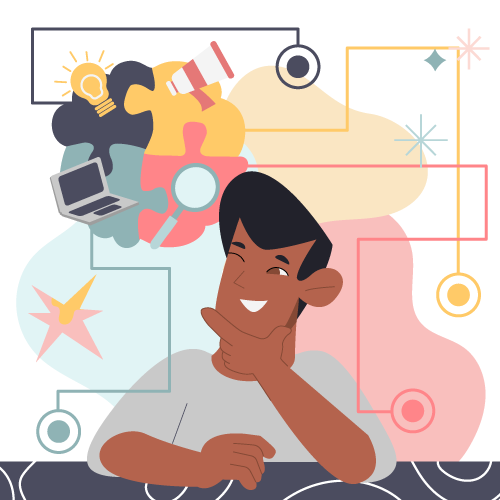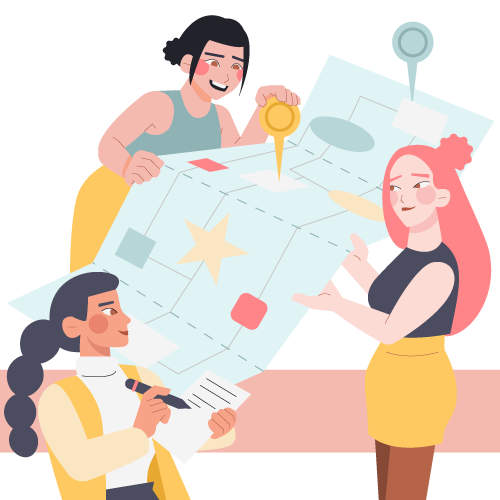The idea that happy, seemingly engaged learners will instantly retain information is one of many learning myths that can render your eLearning ineffective. Understanding information and retaining it long-term are very different things.
If you want people to retain information, you have to design your modules with that goal in mind. Let’s break down the reasons your employees forget what they’ve learned and how you can make a few simple changes for lasting results.
What is knowledge retention?
Knowledge retention is all about our ability to recall things we’ve learned far into the future. It’s one thing to recount a lesson or conversation you had a couple of minutes ago, but when you’re training team members, you need them to retain that information for months or years.
Knowledge retention is the ability to absorb information and remember it over time—especially when that knowledge needs to be applied on the job. In the workplace, it’s not just about learning something new; it’s about making sure that learning sticks. When employees retain knowledge, they can recall it quickly, make better decisions, and perform tasks more confidently and efficiently.
When employees can recall and utilize the information from their training, it translates into better job performance and fewer errors. This long-term knowledge retention uses an entirely different part of your brain than short-term memory. It also includes a few extra steps
- Encoding—Your brain processes the information so it can be stored, typically by associating it with other memories or personal experiences.
- Storage—Memories are consolidated to boost stability and placed in either sensory memory, short-term memory, or long-term memory.
- Retrieval—Different things can trigger memory retrieval, including yourself and cues in the environment, both of which bring the information back into working memory.
Our modern world constantly presents us with a barrage of information, most of which we don’t need to retain. Everything from an actor’s IMBD page to your partner’s birthday is a few clicks away, so the neural pathways to long-term memory sit largely unused.
This issue only grows when combined with information overload, ineffective learning, and low engagement. To train your workforce in a way that lasts, you need to be intentional about fostering knowledge retention.
10 strategies to improve knowledge retention
Let’s look at ten ways to bake knowledge retention into your eLearning. These straightforward strategies will fit right into your current training system.
1. Spaced repetition
Integrate spaced repetition algorithms into your eLearning platform so learners review the content at increasing intervals. For example, after a learner completes a module, they receive follow-up quizzes that revisit key points one day later, three days later, and a week later.
2. Interactive content
Employ interactive elements such as quizzes, drag-and-drop activities, and simulations. These activities should directly align with learning objectives to reinforce content.
For instance, use branching scenarios in a compliance training module where learners make decisions and immediately see the consequences. The more active your team members are in the learning process, the more memories they will have to encode together.
Related: How to create well-designed interactive elearning
3. Gamification
When you include gamification in your eLearning courses, you get folks excited to learn and motivate them to keep training. This can take the form of:
- Points
- Badges
- Leaderboards
- Progress tracking
- Competition
You might create a module where learners earn points by completing quizzes and interactive challenges. They can progress to more advanced levels as they accumulate points and see how far coworkers have gotten.
4. Multi-sensory learning
Design your eLearning content to engage multiple senses. This gives folks more touchpoints to recall information.
While you likely won’t be able to include scent or taste in a digital classroom, you can bring in more senses by incorporating multimedia elements such as videos, audio clips, images, and text.
5. Elaboration
The Socratic Method allows learners to build on previous knowledge by elaborating on existing concepts and constructing new memories. The more dialogue you can create, the easier it will be for team members to form lasting memories.
When presenting information, instead of simply asking learners to repeat it back, encourage them to apply it in different situations and explain how it relates to what they already know.
6. Microlearning
Working against information overload is a great way to help people retain information without extra strain. Create microlearning modules that focus on single topics or concepts, delivered in short bursts of 3 to 7 minutes.
These can be video clips, infographics, or quick interactive tasks. For example, create a series of brief videos followed by a quick quiz on each topic. These can be administered throughout the day, and learners will be surprised by how much they’ve retained.
Related: What is microlearning?
7. Consistency and routine
Develop a structured eLearning schedule that encourages consistent study habits. While cramming in modules all at once might help in the short term, retaining information needs more consistency. When you build eLearning into the day-to-day operations of your company, you foster a continuous learning culture.
Design courses with a predictable layout and schedule to foster routine learning. You can schedule regular knowledge checks or interactive assignments to maintain a steady learning rhythm and send automated reminders to prompt learners to complete their tasks.
8. Personalized learning paths
When it comes to training, one size never fits all. Some employees will come in with a wealth of knowledge or deep interest in one topic but no clue in others. You might have someone who is extremely motivated to learn but is starting without the base information others have.
You can combat this with adaptive learning technologies. Create personalized learning paths based on individual learner’s performance, preferences, and needs. This ensures folks aren’t bored during lessons and have enough time to focus on the areas they need help in.
9. Frequent assessments
Incorporate regular assessments, both formative (ongoing) and summative (final), throughout the eLearning course. These might be:
- Quizzes
- Reflection questions
- Peer reviews
- One-on-one check-ins
This ensures learners fully understand a concept before moving on, making them far more likely to remember it in the future. It also allows you to flag any issues people are having with the lessons or system.
Related: How to create meaningful learning assessments
10. Storytelling
Our minds are hardwired to engage with and remember stories. You can use this to your advantage by using narrative techniques to make the learning content more relatable and memorable.
Use storytelling to explain complex concepts or present case studies. This will give your team members real-world examples of the information being implemented and give them an emotional connection to the work.
The role of engagement in knowledge retention
It’s been proven time and again that engaged learners will retain information far longer. This makes sense. If nothing is pulling you in during a lesson, your mind is likely to wander. Long-term retention of knowledge requires a learner to be fully invested and actively engaging with the material.
You likely recall the plot of your favorite video game far more than the plot of a book you skimmed for class in eighth grade. Even though you wrote an essayon the book, you were actually engaged with the game.
You can put this concept to work during your eLearning by including features like interactive content, gamification, and personalized learning paths. This boosts both knowledge and learner retention.
The ability of your organization to keep employees motivated and committed to learning is learner retention. When this is high, it means employees are more likely to keep developing professionally and adapt quickly to changes in business strategies and technologies.
Extending knowledge retention shows team members the value of your eLearning modules and keeps them invested going forward. The more engaged they are, the faster your business will grow.
Leveraging technology to boost retention
Technology can do more than just deliver training—it can transform the learning experience into something more engaging, adaptive, and memorable. When used strategically, tech becomes a powerful ally in boosting knowledge retention across your workforce. Here’s how:
1. Spaced Repetition Tools
What it is: Spaced repetition involves presenting information at increasing intervals over time, which is scientifically proven to improve long-term memory.
Practical application: Use tools like Anki, Qstream, or LMS features that support automated quiz reminders and refreshers.
Design principle: The Forgetting Curve (Ebbinghaus)—spacing content combats natural memory decay.
2. Microlearning Modules
What it is: Short, focused bursts of learning (typically 5–10 minutes) that target one concept or skill at a time.
Practical application: Break down training into snackable lessons that can be accessed on-demand via mobile or desktop.
Design principle: Cognitive Load Theory—smaller chunks reduce mental overload, allowing better processing and retention.
3. Scenario-Based Learning & Simulations
What it is: Immersive, interactive experiences where learners apply knowledge in realistic contexts.
Practical application: Use branching scenarios or gamified simulations to practice decision-making in safe environments.
Design principle: Situated Learning Theory—contextual learning supports transfer and memory retention.
4. Adaptive Learning Platforms
What it is: AI-driven tools that adjust content delivery based on learner performance and behavior.
Practical application: Platforms like Docebo, Smart Sparrow, or Axonify tailor experiences based on user knowledge gaps and learning pace.
Design principle: Personalization & Mastery Learning—meeting learners where they are improves outcomes and engagement.
5. Learning Reinforcement via Push Notifications or Email Nudges
What it is: Timely reminders and content nudges that keep training top of mind.
Practical application: Send “Did You Know?” tips, scenario refreshers, or mini-quizzes through mobile apps or email outreach campaigns.
Design principle: Reinforcement Theory—frequent, low-effort reinforcement drives retention and recall.
6. Social & Collaborative Learning Platforms
What it is: Tools that facilitate peer discussion, coaching, and feedback (e.g., Microsoft Teams, Slack integrations, or discussion boards).
Practical application: Integrate post-training prompts or discussion threads to reflect on learnings and share examples from the job.
Design principle: Constructivist Learning Theory—social interaction supports deeper understanding and long-term memory.
Measuring the impact of retention strategies
Depending on their company culture, market niche, and team makeup, every organization will find success with different strategies for engagement and knowledge retention. Your journey will likely involve trial and error to see what works for you.
The best way to zero in on the perfect plan is by tracking the success of each strategy and moving forward with the one that works best. This can be done with A/B testing, iterative trials, or focus groups.
However you test strategies, you need to have clear parameters in place to measure their success. These are some of the most insightful KPIs for finding the retention plan that resonates with your team.
- Training completion rate—This is the percentage of employees who complete the training program. High completion rates can indicate that employees find the training accessible and engaging
- Assessment scores—Pre- and post-training assessment scores show the effectiveness of training. Re-test after a week or more to see how much knowledge was retained.
- Course engagement metrics—Time spent on modules, participation in interactive elements, and frequency of course logins show how invested learners were in the material.
- Employee feedback and satisfaction—Use surveys or feedback forms to collect employees’ thoughts on the training. Positive feedback can signify perceived value and effectiveness, meaning more engagement and retention in the long run
- Application of knowledge in the workplace—Observational data or performance metrics show how employees apply the training in their roles. Real-world application over time indicates how well the information is retained
- Reduction in error rates—Monitor the decrease in mistakes or errors in tasks related to the training material. A decline in errors can highlight effective knowledge retention and application
- Time to competency—Track the duration for employees to reach a specified competence level post-training. A shorter time to competency reflects successful knowledge retention.
When you watch these KPIs, you can see the effectiveness of certain strategies in real-time. Use this information to improve upon your eLearning and create the ultimate training program.
When Learning Lasts, Performance Follows
Learning something new is only helpful in the workplace if that knowledge is retained. When you take the time to craft engaging, continuous educational material, you hack into your team’s minds and make sure information stays put.
By implementing some of the strategies outlined here and working with the right tools for the job, you can rest assured that employees will remember their training when it counts.
Explore how our custom eLearning solutions help teams retain more—and perform better. Let’s design a solution that sticks.





